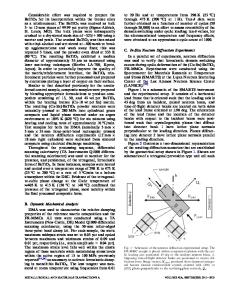Ferroelastic Domain Switching In Tetragonal Zirconia
- PDF / 1,646,918 Bytes
- 6 Pages / 420.48 x 639 pts Page_size
- 30 Downloads / 332 Views
FERROELASTIC DOMAIN SWITCHING INTETRAGONAL ZIRCONIA 2 2 C.J. Chan%', F. F. Lange', M.RUhle**.,,J. F. Jue and A.V.Virkar 'Materials Department, University of California, Santa Barbara, CA 93106 2 Department of Materials Science and Engineering, University of Utah, Salt Lake City, Utah 84112
ABSTRACT Ferroelastic domain switching is one of the possible toughening mechanisms in ceramic materials. Microstructural evidence of domain reorientation (switching) inpolydomain tetragonal zirconia single crystals is observed upon the application of a unidirectional compressive stress. Dark field imaging of the three 1112) tetragonal twin variants ina [111] zone indicates that two sets of twin variants grow at the expense of the third set upon application of uniaxial compression. The diminishing variant is the one with its c axis parallel to the compression axis. Indentation experiments on uniaxially compressed samples show an anisotropy in crack length. Crack propogates more easily along the loading direction. A construction for the orientation relationship of domains and their twin boundaries is presented. INTRODUCTION Ferroelasticity is the mechanical analogue of ferromagnetism and ferroelectricity. The lerroelastic state is characterized by the existence of a permanent strain and a hysteresis loop between the strain and its applied stress, as shown inFigure 1. According to Michel et al., a metastable tetragonal (t') zirconia is a ferroelastic phase [1]. There are at least two energetically equivalent orientational states existing in the crystal. In principle, crystal orientation may be induced from one state to the other by applying an appropriate external stress (2]. The area within the hysteresis loop is the mechanical energy absorbed in the reorientation process. Figure 1. Schematics showing hysteresis loop for
aS
(. . 11C
E
(a) ferromagnetic, (b) ferroelectric, and (c) ferroelastic materials. Shaded area is the mechanical energy absorbed in domain reorientations.
Ferr oinognelic
(a)
Fewroelecilr ic
Fewroelos tic
(b)
(c)
Virkar and Matsumoto [3) observed an increase in the (002) peak intensity and a simultaneous decrease in the (200) peak intensity after surface grinding on ceria-stabilized tetragonal zirconia (Ce-TZP) ceramics. The development of crystallographic texture was attributed to the switching of ferroelastic domains by the externally applied stress. They further proposed that domain reorientation may provide a requisite energy absorption mechanism for enhancement of fracture toughness. This mechanism differs from stress-induced transformation toughening in that there is no change in crystal structure, but only reorientation of twin variants within the process zone. Recent work of Srinivasan et al. [4] on polydomain tetragonal ziiconia single crystals indicated that ferroelastic domains underwent reorientation under compression at temperatures as high as 1400TC. X-ray diffraction from high temperature fracture surfaces showed that domain reorientation had occurred with no monoclinic phase observed.
Data Loading...











